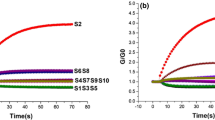Abstract
This paper describes an investigation into the performance of a Neural Network (NN) based Electronic Nose (EN) system, which can discriminate the aroma of different tea grades. The EN system comprising of an array of four tin-oxide gas sensors was used to sniff thirteen randomly selected tea grades, which were exemplars of eight categories in terms of aroma profiles. The mean and peak of the transient signals generated by the gas sensors, as a result of aroma sniffing, were treated as the feature vectors for the analysis. Principal Component Analysis (PCA) was used to visualise the different categories of aroma profiles. In addition, K-means and Kohonen’s Self Organising Map (SOM) cluster analysis indicated there were eight clusters in the dataset. Data classification was performed using supervised NN classifiers; namely the Multi-Layer Perceptron (MLP) network, Radial Basis Function (RBF) network, and Constructive Probabilistic Neural Network (CPNN) were used for aroma classification. The results were that the three NNs performed as follows: 90.77, 92.31, and 93.85%, respectively in terms of classification accuracy. Hence the performance of the proposed method of aroma analysis demonstrates that it is possible to use NN based EN to assist with the tea quality monitoring procedure during the tea grading process. In addition the results indicate the possibility for standardization of the tea aroma in numeric terms.








Similar content being viewed by others
References
P.K. Mahanta, P. Tamuli, L.P. Bhuyan, J. Agric. Food Chem. 41, 1677–1683 (1993)
H. Horie, S. Fukatsu, T. Mukai, T.G.M. Kawanaka, T. Shimohara, Sens. Actuators B Chem. 13(1–3), 451–454 (1993)
N. Togari, A. Kobayashi, T. Aishim, Food Res. Int. 28(5), 495–502 (1995)
J.A. Wright, M. Fishwick, Phytochemistry 18, 1511–1513 (1979)
T. Yamanishi, in Tea, Coffee and Cocoa and Other Beverages, ed. by R. Teranishi, R.A. Flath, H. Sigisawa. Flavour Research (Marcell Dekker, New York 1981), pp. 231–304
T. Takeo, P.K. Mahanta, J. Sci. Food Agric. 34, 307–310 (1983)
P.O. Owuor, Food Chem. 45, 119–124 (1992)
R. Ravichandran, R. Parthiban, Food Chem. 62(3), 347–353 (1998)
R. Ravichandran, Food Chem. 84(1), 7–11 (2004)
M. Bhuyan, S. Borah, in Use of Electronic Nose in Tea Industry. Proc. Int. Conf. EAIT (IIT, Kharagpur, Dec 10–12, 2001), pp. 848–853
P.N. Bartlett, J.M. Elliot, J.W. Gardner, Food Technol. 51, 44–48 (1997)
J.W. Gardner, Sens. Actuators B Chem. 4, 109–116 (1991)
J.W. Gardner, P.N. Bartlett, Sens. Actuators B Chem. 18(1–3), 210–220 (1994)
E.L. Hines, E. Llobet, J.W. Gardner, IEE Proc. Circuit Devices Syst. 146(6), 297–310 (1999)
J.C. Bezdek, Pattern Recognition with Fuzzy Objective Function Algorithms (Plenum Press 1981)
T. Kohonen, Proc. IEEE (special issue on Neural Network) 78(9), 1464–1480 (1990)
D.E. Rumelhart, G.E. Hinton, R.J. Williams, Nature 323, 533–536 (1986)
J. Moody, C. Darken, Neural Comput. 1(2), 281–294 (1989)
M.J. Berthold, J. Diamond, Neurocomputing 19(1–3), 167–183 (1998)
Acknowledgements
The authors wish to thank the Commonwealth Scholarship Commission in London for their funding, and support for S. Borah, without which the work would not have been possible.
Author information
Authors and Affiliations
Corresponding author
Rights and permissions
About this article
Cite this article
Borah, S., Hines, E.L., Leeson, M.S. et al. Neural network based electronic nose for classification of tea aroma. Sens. & Instrumen. Food Qual. 2, 7–14 (2008). https://doi.org/10.1007/s11694-007-9028-7
Received:
Accepted:
Published:
Issue Date:
DOI: https://doi.org/10.1007/s11694-007-9028-7




